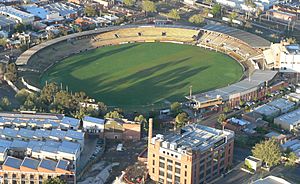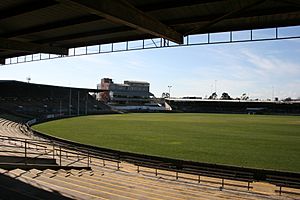Victoria Park, Melbourne facts for kids
|
Old Girl, VP, Vic Park
|
|

Victoria Park in 2007
|
|
| Former names | Dight's Paddock Jock McHale Stadium |
|---|---|
| Location | Abbotsford, Victoria |
| Coordinates | 37°47′54″S 144°59′47″E / 37.79833°S 144.99639°E |
| Owner | City of Yarra |
| Operator | City of Yarra |
| Capacity | 10,000 |
| Surface | Grass |
| Construction | |
| Opened | 1879 |
| Construction cost | £600 |
| Architect | William Pitt |
| Tenants | |
| Collingwood Football Club Administration & Training (1892–2005) VFL/AFL (1892–1999) VFL (2010–present) AFLW (2018–present) VFLW (2018–present) Other teams: Fitzroy Football Club (VFL) (1985–1986)Fitzroy Stars (NFL) (2010–2012) Collingwood Warriors (NSL) (1996–1997) |
|
Victoria Park is a famous sports ground in Abbotsford, a suburb of Melbourne in Victoria, Australia. This oval-shaped stadium was built for Australian rules football and cricket games. In the past, it also had a cycling track, tennis courts, and a baseball club.
Victoria Park is very important in history. It was a main ground for the Australian Football League (AFL) from 1892 to 1999. It was also the home base for the Collingwood Football Club for 107 years until 2004. The Fitzroy Football Club also played some games there in 1985 and 1986. This ground is so special that it is listed on the Victorian Heritage Register.
At its busiest, from 1959 to the late 1980s, Victoria Park was one of the biggest VFL stadiums. But in the 1990s, the AFL wanted clubs to play at larger grounds. Collingwood played its last AFL game there in 1999. The club still used Victoria Park for training until 2005. Today, Collingwood's AFL Women's, VFL Women's, and Victorian Football League teams play their home games at Victoria Park.
History of Victoria Park
From Dight's Paddock to a Sports Ground
Victoria Park started in 1879 on land called Dight's Paddock. This land was used for grazing cattle since 1838. In 1878, Fred Brown bought the 12 hectares (about 30 acres) of land. By 1882, the land was given to the people of Collingwood for fun and recreation. A cricket pitch and a cycling track were soon added. Local cricket and junior football clubs began using the ground.
Collingwood Football Club's Home Ground
The Collingwood Football Club played its first game at Victoria Park in 1892. About 16,000 fans watched, showing how popular the club and the ground quickly became.
The first big stand was finished in 1892. Soon, the club asked the council for more money to build better facilities. In 1900, the Ladies Stand was built. In 1909, the Member's Stand was designed. The Ladies Stand was replaced in 1929 by the Jack Ryder Stand. This new stand had modern facilities for players and could seat about 3,000 fans.
By the end of 1929, Collingwood had won three football championships in a row. They were almost unbeatable at Victoria Park. This was a tough time for many people because of the Great Depression. Watching the Magpies win gave many unemployed people a break from their worries. The club even let them into games for free.
The biggest crowd ever at Victoria Park was in April 1948. About 47,000 people watched Collingwood beat South Melbourne.
In 1953, Collingwood won another championship. The club's secretary, Gordon Carlyon, wanted to improve the ground. He worked hard to get the council to agree to a long-term lease. After some back-and-forth, Collingwood finally gained control of its home ground until 1996.
Upgrades and New Stands
The first new building was the social club, which opened in 1959. It is now known as the Bob Rose Stand. The next stand, the R.T. Rush Stand, opened in 1966. It was special because its roof had no poles, giving fans a clear view. The old Member's Stand was replaced by the Sherrin Stand, which was finished in 1978.
Work continued to improve the ground into the late 1980s. However, new plans for more covered seating faced problems. Local residents and new council members stopped the club from continuing the upgrades.
Fitzroy Football Club's Time at Victoria Park (1985–1986)
Victoria Park was also the main home ground for the Fitzroy Football Club in 1985 and 1986. They shared the venue with Collingwood. In 1987, Fitzroy moved its home games to Princes Park.
The End of AFL Games at Victoria Park
In the late 1980s, Collingwood started playing some of its home games at the Melbourne Cricket Ground (MCG). Playing at larger venues like the MCG helped the club financially. These stadiums had lights for night games, which meant more people could watch on TV and in person.
By 1994, Collingwood played most of its games at the MCG. In 1998 and 1999, only two games each year were played at Victoria Park. The cricket club also moved away in 1996 after 100 years.
The very last top-level football game at Victoria Park was in 1999. Collingwood played the Brisbane Lions and lost. This was the end of an era for the ground.
After 1999, Collingwood stopped using Victoria Park for AFL home games. However, the club still used it for training and administration until 2005. The ground is still seen as the club's spiritual home. Collingwood moved its main facilities to the Olympic Park Complex in 2004.
There were plans to knock down parts of the ground. But because Victoria Park is a protected heritage site, it could not be demolished. The oval itself was always planned to stay.
Victoria Park Today
In 2009, the City of Yarra council allowed Collingwood's VFL team to play matches at Victoria Park again. The team now plays some home games there. Since 2018, Collingwood's women's teams in the AFL Women's and VFL Women's leagues also play most of their home matches at the venue. This means Victoria Park is still a busy place for football.
The ground is also used by the AFL Victoria umpiring department. They train umpires for various competitions.
Making Victoria Park Better
In May 2010, the Yarra City Council announced a big upgrade for Victoria Park. The goal was to make it a major community recreation space. Over $7.2 million was spent on these improvements. The AFL, Collingwood Football Club, and the Australian government all helped pay for it.
The upgrades included:
- Creating two public areas with trees, seating, and barbecues.
- Fixing up the outside of the Sherrin, Ryder, and Bob Rose stands.
- Removing part of the old brick wall along Lulie Street.
- Making the walls along Turner Street lower.
- Building a copy of an old ticket booth and fixing another one.
- Adding public artworks to celebrate the park's history.
- Installing a ramp for people with disabilities at the Ryder stand.
- Building a walking path around the oval and replacing the boundary fence.
These works were finished in 2011. The new and improved ground opened to the community on December 4, 2011.
Upgrades for Women's Football
In May 2020, another $2 million upgrade began. This project was funded by the Victorian Government, City of Yarra, AFL, and Collingwood. The Sherrin Stand was updated. New changing rooms and recovery facilities were built for the club's female players. This allowed the women's teams to make Victoria Park their main base. These upgrades were ready for the 2021 season.
What Victoria Park Looks Like
Victoria Park has an oval shape to fit its playing field. While there were no big screens during its main years, one was brought in by a crane for the final game.
The ground has several important grandstands:
- Bob Rose Stand: Opened in 1959, this stand was Collingwood's social club and administration office until 2004. It had standing room for fans and some seats inside the social club.
- R.T. Rush Stand: Finished in 1965, this stand was special because its roof had no poles blocking views. It ran along the southern side of the oval. This stand was taken down in 2011, with only a small piece left as a reminder.
- Sherrin Stand: This area was often used by the Collingwood cheer squad. It is behind one of the goals. Part of the stand is covered, with some rows of seats in the open.
- Ryder Stand: Completed in 1929, this stand was built by unemployed workers from Collingwood. It has wooden seats and is completely covered. It was restored in 2010-2011.
The eastern end of the ground used to have grass for standing fans and a scoreboard, but no stand. It was taken down in 2011. The ground never had lights for night games. Some smaller lights were added for darker daytime games. Fans entered the ground through turnstiles.
Victoria Park can hold about 10,000 people today. The record crowd was 47,224 in April 1948.
Getting to Victoria Park
The ground is about 4 kilometers northeast of the Melbourne central business district. On game days, there was limited parking, but this is no longer available. Victoria Park has its own train station about 200 meters away. It is on the Hurstbridge and Mernda train lines.



